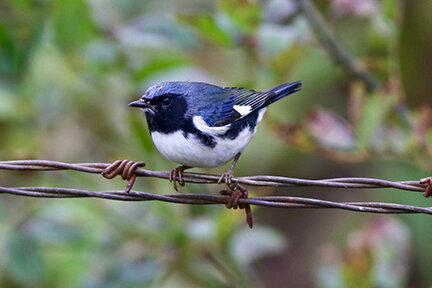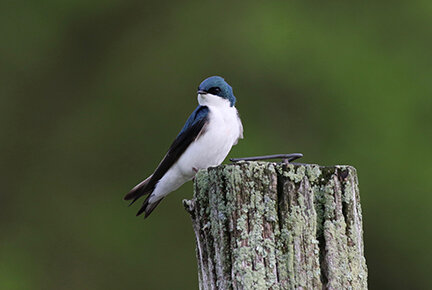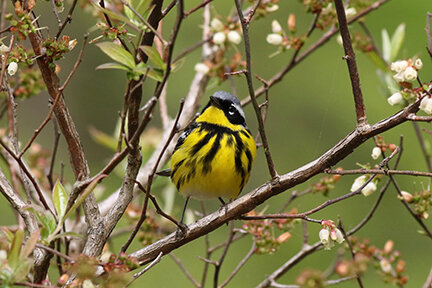Trout Brook Valley Conservation Area (Trout Brook Valley, Jump Hill, and Crow Hill Preserves) offers some of the best birdwatching in the state of Connecticut. Over 200 species have been recorded in the preserve, and it is possible to find nearly half of these in a single day in mid-May, when flashy, charismatic migrant warblers fill the trees. Almost any trail in the preserve offers up avian goodies, and there are interesting and unusual birds to find during any season. For a comprehensive and up-to-date list of species you are likely to find during a particular season, check out Cornell’s eBird website for this location.
Aspetuck Land Trust has joined forces with the global community of citizen scientists through the iNaturalist app. You can now add your wildlife sightings to iNaturalist when you hike in Trout Brook Valley. This helps us document and manage the property and is a great activity for kids! Pick up or photograph a trail map at one of the four preserve parking lots or get a printable trail map. Here are some of the most productive areas to look for birds:
The Orchard
This crown jewel of Trout Brook Valley is not only a fantastically majestic hiking destination, but it is often packed with birds! During spring and fall migration, flycatchers, warblers, sparrows, hawks, and finches abound, and many interesting and rare birds have been spotted here. Enter the orchard from the magenta trail and bird the entire perimeter, including the blueberry patch and the hedgerows around the barn and the orchard’s northern end. Try to arrive early as most birds are more likely to be actively feeding and singing in the early morning, except for migrating hawks that rely on thermals generated by mid-day heat.
In spring (May), look for striking Bobolinks in the orchard’s grasses and apple trees, and colorful migrant warblers in the hedgerows and forest edges. If you are lucky enough to visit early on a mid-May morning during a migrant fallout (try the morning after a night with southwest winds following a several-day period with blocking winds from the north; add a passing early morning rain shower, if you are so lucky, and the trees will be dripping with warblers), you might find twenty or more species of warblers without leaving the orchard, including uncommon beauties such as Wilson’s, Blackburnian, Bay-breasted, and Cape May Warblers. Common flycatchers including Eastern Kingbird, Willow Flycatcher, Eastern Phoebe, and Eastern Wood-Pewee may be joined by scarce migrants such as Yellow-bellied and Olive-sided Flycatcher.
Tree Swallow – Photo Credit: Jeremy Nance
In summer (June and July), look for nesting Eastern Bluebirds, House Wrens, and Tree Swallows in the bird boxes hung on the perimeter fence, and Field Sparrows singing their ‘bouncing ball’ song from bushes at the orchard’s edge. Listen for the eerie clucking song of Yellow-billed Cuckoos from the forest edge. Several locally scarce nesting birds have been sighted here regularly in the summer, including White-eyed Vireo, Bobolink, and Brown Thrasher. The very rare and stunning Scissor-tailed Flycatcher, a southern grassland bird, has been found in the orchard twice in early June. And if you visit to pick blueberries in July, look out for Catbirds, Baltimore and Orchard Orioles, Scarlet Tanagers, Rose-breasted Grosbeaks and Wild Turkeys with their poults eating blueberries too.
Fall (August to November) is peak season in the orchard, with large numbers of migrants visiting on days following a cold front with northwest winds. In September, check the hedgerows and blueberry patch for flocks of migrant warblers. Tail-wagging Palm Warblers can be abundant along the perimeter fence, and the rare and secretive Connecticut Warbler has been seen here several times during September. Look for it in tangles at the forest edge bordering weedy fields. Other rarities found in September include Red-headed Woodpecker, Mourning Warbler, Yellow-breasted Chat, Philadelphia Vireo, Olive-sided Flycatcher, Yellow-bellied Flycatcher, Clay-colored Sparrow, and even Say’s Phoebe - a western species that has only been seen in Connecticut a few times. From mid-morning onwards, look for migrating hawks passing overhead, particularly on days with strong northerly winds. A great spot to position yourself is on the north slope of the orchard; look for high-flying hawks crossing over from the ridge to the east, making their way to the southwest. Large kettles of Broad-winged Hawks have been seen in September, and Sharp-shinned and Cooper’s Hawks regularly zoom by. Bald Eagles occasionally soar overhead, and rarities including Golden Eagle and Northern Goshawk have been sighted in late fall. October brings large numbers of migrant sparrows. Among the more common sparrows such as Song, Swamp, White-throated, Field, and Chipping, look out for less common species including White-crowned, Lincoln’s, Clay-colored, Vesper, and the secretive Grasshopper Sparrow. Listen overhead for the buzzer-like call of the Dickcissel – an uncommon but regular fall visitor which is more often heard than seen. From September to November, look and listen for winter finches, including Pine Siskins and Purple Finches, which are often heard calling as they pass overhead after a fall cold front. In irruption years, flyby Evening Grosbeaks, Common Redpolls, and even Red Crossbills have been observed here. Your best bet for encountering these northern specialties is to watch and listen (learning their flight calls is essential for this) from the crest of the orchard or the north slope. In late fall, look for Rusty Blackbirds and Eastern Meadowlarks flying by or feeding in the fields, and check flocks of Horned Larks and American Pipits in the plowed farm fields for Snow Buntings and Lapland Longspurs - often first detected by their rattling calls.
In winter, look for small flocks of rusty-capped Tree Sparrows and overwintering Vesper and White-crowned Sparrows among the regular wintering sparrows. Spectacular Eastern Bluebirds frequently decorate the tops of apple trees in small social foraging groups. Infrequent visitors such as Evening Grosbeak, Short-eared Owl, Long-eared Owl, Snow Bunting, and even the rare Bohemian Waxwing have been found during this season.
Bradley Road Loop
Magnolia Warbler – Photo Credit: Jeremy Nance
The forests, hillsides, meadows, and marshes around the Bradley Road entrance are excellent for finding birds from spring through fall. From the Bradley Road parking area, take the white trail to the green trail, and return on the violet trail (or try this loop in the opposite direction). Just after leaving the parking area, the trail passes a wetland (formed by a beaver dam blocking Hawley’s Brook) full of interesting species. Common breeding birds include Yellow Warblers, American Redstarts, Baltimore Orioles, and Rose-breasted Grosbeaks. During migration, look for Magnolia, Canada and Wilson’s Warblers, and the secretive Mourning Warbler has been found at this spot several times in late May (listen for its distinctive song – Mourning Warblers are almost always heard before seen). Both Yellow-billed and Black-billed Cuckoos are frequently heard and occasionally seen in May, and Acadian Flycatcher is a regular nester despite being relatively scarce in much of the state. Uncommon birds that have been noted in the marshy area in spring include Alder flycatcher (mid-May), Virginia Rail and Marsh Wren.
Continue past the marsh, staying on the white trail. Barred Owl is regularly heard or seen along this stretch, and both Worm-eating Warblers and Acadian Flycatchers are regular in spring and summer. Common nesting birds include Black-and-white Warblers, Scarlet Tanagers, and both Red-eyed and Yellow-throated Vireos. Eventually, the trail opens up into a clearing whose borders can be filled with warblers and other migrants in May. The locally rare Cerulean Warbler has been found at this spot several times in May. Look for migrants such as Bay-breasted, Black-throated Blue, Chestnut-sided, and Blackburnian Warblers in the oaks, and Wilson’s Warbler, Canada Warbler, and Least Flycatcher in the shrubs.
Continue on the white trail over the Hawley’s Brook fish ladder and turn left onto the green trail. Turn left again from the green trail onto the violet trail to head back south to Bradley Road. The violet trail passes through a rich stand of hemlocks in the bottom of Trout Brook Valley and features several breeding birds, such as Hermit Thrush, Winter Wren and Black-throated Green Warbler, that are normally only found further north. Worm-eating and Black-and-white Warblers are common along this stretch in spring and summer, and listen for Acadian Flycatcher and Louisiana Waterthrush along the creek.
The Red Trail
The red trail from Bradley Road quickly takes you from the floor of Trout Brook Valley to a high ridge and the purple trail to Popp Mountain. The red trail can be fantastic during spring and fall migration early on a sunny morning, just as the sun paints the ridgetops with light, attracting hungry migrants searching for insects. This is the most reliable trail in the preserve for sought-after migrants such as Tennessee, Bay-breasted, Blackburnian, and Cape May Warblers. Look for them in spring or fall in the hemlocks and oaks catching early light. Blue-headed Vireo, Winter Wren, and Hermit Thrush likely nest here – all birds more typically found further north. Check the wet ravines for Canada Warbler (May) and Louisiana Waterthrush (spring and summer), and listen for cuckoos. After returning to the red trail, either retrace your steps back to Bradley Road, or continue north until it intersects with the green trail. Turn right onto the green trail and follow it back to Bradley Road.
Jump Hill Preserve
Black-throated Blue Warbler – Photo Credit: Jeremy Nance
The northern section of Trout Brook Valley Conservation Areas sees fewer visitors but still offers excellent forest bird variety. After leaving the Jump Hill parking area, check the barberry thickets for Eastern Towhees, and during migration, Black-throated Blue Warblers and the uncommon White-eyed Vireo and Nashville Warbler. Hooded Warblers, which favor forest with dense understory, have nested in this area. During spring migration, hike the white and yellow trails, which travel along a ridge dotted with oaks that catch early morning light. Bay-breasted, Chestnut-sided, Blackpoll, and Blackburnian Warblers can occasionally be found here among the more common migrants. Scarlet Tanagers and Worm-eating Warblers are common nesting birds in this section of the preserve.
This birding guide was written by ALT member and birder Jeremy Nance. For more information, Jeremy can be reached at nance.jeremy@gmail.com.





